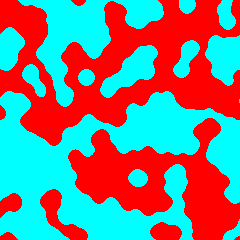 |
Program in Probability and Its Applications
Coxeter Lecture Series
 |
Rick Durrett, Cornell University
May 11 - 12, 1999
|
|
DNA REPEAT SEQUENCES
May 11, 1999
Repeats of short patterns such as CACACA... appear in our DNA
at a frequency far greater than if they were due to chance. These
repeats have a high mutation rate compared to nucleotide substitutions,
so they are useful for locating genes and for understanding population
structure on the scale of thousands of years. In this talk we
will describe a simple model of the evolution of these repeat
sequences developed in joint work with Semyon Kruglyak, Malcolm
Schug, and Chip Aquadro, and we will fit this model to DNA sequence
data from yeast, fruit flies, mice, and humans. The model fits
the observed data and gives parameter estimates that are consistent
with experimental work.
|
|
STOCHASTIC SPATIAL MODELS; EASY AS 1, 2, 3
May 11, 1999
In many situations in biology it is useful to consider a model
that represents space as a grid of sites, each of which can be
in one of a finite number of states and changes at a rate that
depends on the state of finitely many neighbors. Durrett and Levin
proposed in 1994 that the behavior of these systems can be inferred
by looking at the associated "mean field" ODE that is obtained
by pretending that all sites are always independent. We will describe
the answers that result from this approach for a number of systems
of interest in biology and illustrate our results by a videotape
of computer simulations.
|
|
SCALING LIMITS OF PARTICLE SYSTEMS
May 12, 1999
It has long been known that scaling limits of critical branching
random walks lead to an interesting measure valued process, now
called super-Brownian motion. Here we describe recent results
which show that in two or more dimensions super-Brownian motion
is the limit of rescaled contact processes and voter models. To
get more interesting limits in d=2 or 3 one can (we think) take
multitype contact processes like the colicin systems of Durrett
and Levin (1997) and let the interaction parameters between species
get large at the right rate to get convergence to models that
generalize the interacting super-Brownian motions constructed
by Evans and Perkins (1998). Some theorems and simulations will
be shown in support of this picture.
|
| |
|
|
 |